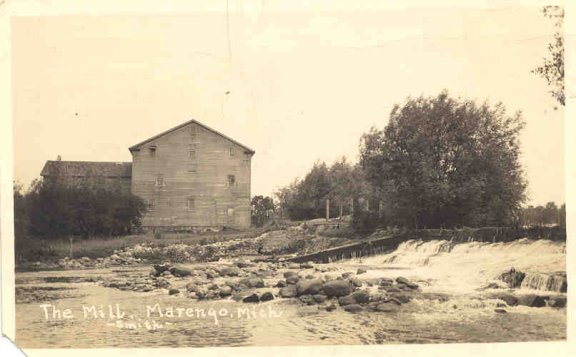Marengo Township History
Marengo Township holds the distinction of being the second oldest settled community in Calhoun County, after the City of Marshall. On the 16th day of June 1831, four entries of land were made in the township, six years before Michigan obtained statehood. Settlers to the area were attracted to the possibility of utilizing waterpower along the Kalamazoo River. A water-powered flour/grist mill was erected in 1839 and a village soon sprang up there which took the same name as the township. The Village of Marengo is just south of Michigan Avenue along 23 Mile Road (State St.). The Village of Marengo Cemetery was organized, and the first interment was in 1837.
The original mill burned in 1844 but was rebuilt in 1847 by Miller Evans who owned and operated the Marengo Mills for the next three decades. It was one of the leading flour mills in Southern Michigan and flour was shipped as far as New York City. The mill was serviced by a side railroad track. A log building served as the mill warehouse. Evans also operated a sawmill south of the flour mill on the river dam. There was an abundance of white oak trees in the area which supplied the wood for the sawmill, from which many buildings in Marengo were constructed. Further downstream was the Marengo distillery off B Drive North.
19th century plat maps show large village boundaries stretching from Alcott St. on the north, to a proposed Washington St. on the south, which is two lots south of the Marengo "South Brick" schoolhouse south of B Drive North. Over 80 blocks were proposed containing 10 lots each with over 29 named streets. It didn't make it. College St. was once the "business section" of town. A Union Church was erected there in 1854, which today is known as the Marengo Church. The village once had its own hotel on the southeast comer of Elizabeth and College Streets. It was built in 1855 by Winn Gardiner and contained a bar room, a store, a dining room, and a dance hall where monthly dances and parties were held. The hotel was extremely popular and attracted scores of people from throughout Calhoun County. The counter of its basement bar room was 30 feet long, and during the Civil War, the hotel employed four bartenders to keep up with the demand. This structure unfortunately burned in March 1889. There was a cooper shop on Winter St. where barrels were made. Marengo also had a buggy shop, a shoe and boot store, a butcher shop, a distillery, two general stores, two blacksmiths, two physicians, and an insurance agent. The Township experienced slow but steady growth throughout the 20th Century.
Mail service in Marengo township began in 1931 at the home of pioneer/first postmaster Seeley Neal on the south side of Michigan Avenue a mile west of the future village. The office was moved across the road to the nearby tavern of Loren Maynard (who then became postmaster) in 1922 when a regular stage-coach mail route was established. It was then moved to the village on the southwest corner of Elizabeth and College Streets, across from the Marengo Hotel. The history of the Marengo Post Office parallels the history of various general stores, where the store owner or spouse serviced concurrently as the postmaster, too. Long-time postmaster was flour mill operator John Evans, serving from 1852-1881. The 1894 Atlas of Calhoun County shows a new store at 308 State St. south of the railroad depot. In 1922 Erie Lake purchased the Cooper General Store south of the railroad tracks and operated it during the 1920s. He then purchased the L.H. Jacobs store at 412 State St. north of the tracks around 1930 and moved his business there, assuming the postmastership. The store was known as the Erie Lake General Store. Mr. Lake was the final postmaster of Marengo. In a budget cutting move during the Great Depression, the government closed the Marengo Post Office on October 31, 1933 and since then the Village of Marengo has been “assigned” to the Albion Post Office.

